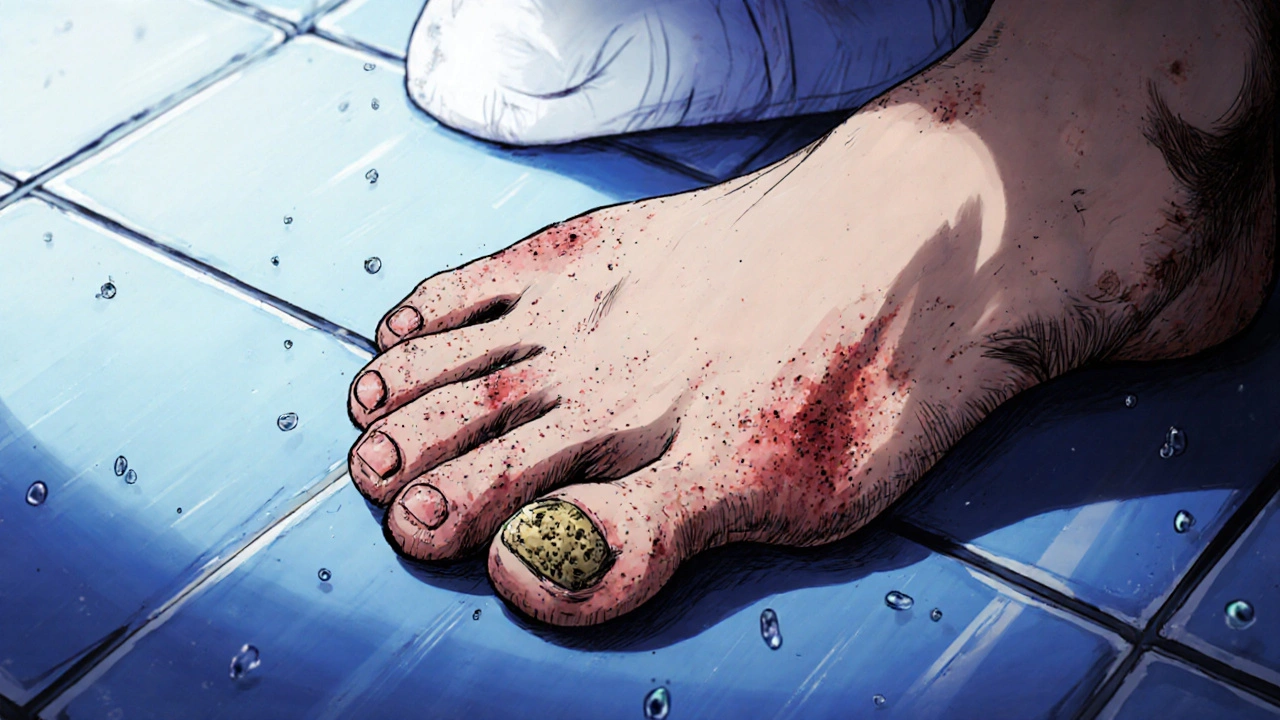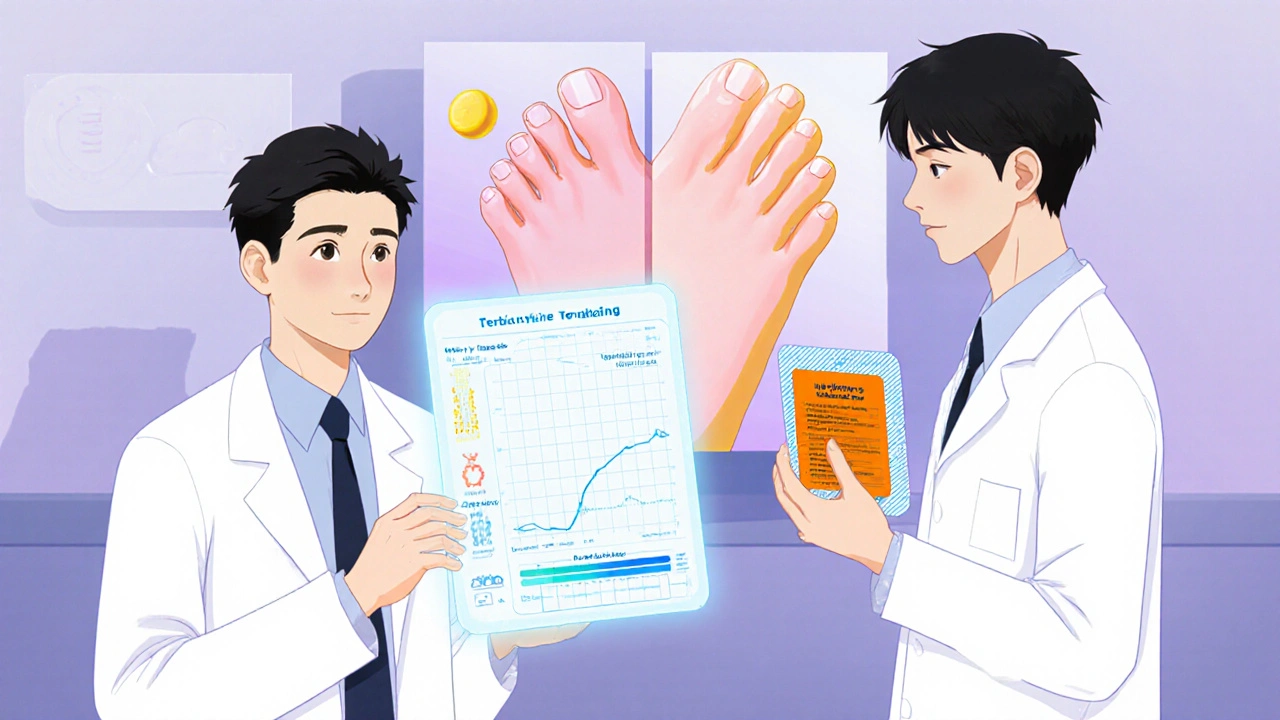Terbinafine Explained: How It Fights Fungal Infections
 Oct, 25 2025
Oct, 25 2025
Quick Takeaways
- Terbinafine blocks the fungal enzyme squalene epoxidase, depleting ergosterol and killing the fungus.
- It works for skin infections like athlete’s foot, ringworm, and nail fungus (onychomycosis).
- Oral tablets are absorbed well, reach high levels in skin and nail keratin, but require liver monitoring.
- Compared with other antifungals (griseofulvin, itraconazole, fluconazole) it cures nail infections faster and has fewer drug interactions.
- Common side effects are mild (headache, taste changes), but serious liver toxicity is rare and predictable.
When you see a scaly rash on your foot or a thickened toenail, the culprit is often a fungus. Terbinafine is a synthetic allylamine antifungal that has become the go‑to medication for many of these infections. Below we break down exactly how it works, why it’s effective, and what you need to know before taking it.
What is Terbinafine?
Terbinafine is a prescription‑only medication that belongs to the allylamine class of antifungals. Marketed under brand names such as Lamisil, it comes in both oral tablets (250 mg) and topical creams or sprays (1 % or 2 %). It was first approved by the FDA in 1991 and quickly gained popularity because it can cure nail infections in months rather than years.
How Does Terbinafine Kill Fungi?
The secret lies in a single enzyme: squalene epoxidase is an essential catalyst in the fungal sterol synthesis pathway. By converting squalene into squalene‑2,3‑epoxide, the enzyme paves the way for producing ergosterol, the fungal equivalent of cholesterol.
When you take terbinafine, it binds tightly to squalene epoxidase, halting the conversion. Two things happen at once:
- Ergosterol depletion - without ergosterol, the fungal cell membrane becomes leaky and can’t maintain its shape.
- Squalene accumulation - the buildup of squalene is toxic to the cell, further destabilising membrane integrity.
This double‑hit is called a fungicidal effect - it kills the organism rather than merely stopping its growth. That’s why terbinafine clears infections faster than many fungistatic drugs.
Pharmacokinetics: How the Body Handles Terbinafine
Understanding absorption, distribution, metabolism, and excretion (ADME) helps explain both its potency and its safety profile.
- Absorption: Oral tablets are absorbed about 70 % from the gastrointestinal tract. Food can slow the rate but not the total amount absorbed.
- Distribution: The drug is highly lipophilic, so it concentrates in keratin‑rich tissues - skin, hair, and especially nails. Nail concentrations can be 10‑20 times higher than plasma levels after a few weeks of therapy.
- Metabolism: The liver processes terbinafine mainly via cytochrome P450 2D6 (CYP2D6). This is why patients who are poor CYP2D6 metabolizers may see higher blood levels and a slightly increased risk of side effects.
- Excretion: About 70 % is eliminated unchanged in urine, the rest in feces. The half‑life is long - approximately 36 hours - allowing once‑daily dosing.
Forms of Terbinafine: Topical vs. Oral
Both preparations aim to get the drug to the infected site, but they differ in speed and depth of reach.
- Topical creams, gels, or sprays (1 %-2 %) - great for superficial infections like athlete’s foot (tinea pedis) or jock itch (tinea cruris). They stay on the skin, so systemic exposure is minimal.
- Oral tablets (250 mg) - required for infections that involve the nail plate (onychomycosis) or deeper skin layers. The drug travels through the bloodstream to the nail matrix, where it builds up over weeks.
Choosing the right form depends on the type and severity of the infection.

Fungal Infections Treated with Terbinafine
Here’s a quick rundown of the most common conditions where terbinafine shines:
- Onychomycosis - fungal infection of the toenail or fingernail. Oral terbinafine achieves cure rates of 70‑80 % after 12 weeks.
- Tinea pedis (athlete’s foot) - itchy, scaling skin between the toes. Topical or oral terbinafine clears symptoms in 1‑2 weeks.
- Tinea corporis (ringworm) - round, red patches on the trunk. Usually a 2‑week topical regimen is enough.
- Tinea cruris (jock itch) - affects the groin area, especially in athletes.
- Tinea versicolor - causes discolored patches on the chest or back; terbinafine cream can be used when other agents fail.
How Terbinafine Stacks Up Against Other Antifungals
| Drug | Class | Mechanism | Typical Use | Cure Rate (Nails) | Key Side Effects |
|---|---|---|---|---|---|
| Terbinafine | Allylamine | Inhibits squalene epoxidase | Onychomycosis, Tinea spp. | 70‑80 % | Headache, taste loss, rare liver toxicity |
| Griseofulvin | Polyenes | Disrupts microtubule function | Superficial skin infections | 30‑50 % | GI upset, photosensitivity |
| Itraconazole | Azole | Inhibits lanosterol 14‑α‑demethylase | Systemic and deep skin infections | 55‑65 % | Heart failure risk, liver enzymes rise |
| Fluconazole | Azole | Inhibits lanosterol 14‑α‑demethylase | Candida infections, some dermatophytes | 40‑55 % | QT prolongation, liver toxicity |
Terbinafine’s advantage is its rapid, fungicidal action and superior nail‑penetration, which translates to higher cure rates and shorter treatment courses.
Dosage, Safety, and Monitoring
Because terbinafine is processed by the liver, doctors usually run baseline liver‑function tests (ALT, AST) before starting therapy and repeat them after 4‑6 weeks for oral courses.
- Typical oral dose: 250 mg once daily for 6 weeks (skin) or 12 weeks (nail).
- Topical dose: Apply a thin layer to affected skin once or twice daily for 2‑4 weeks, depending on the infection.
- Side‑effect checklist:
- Common: headache, gastrointestinal upset, mild skin rash.
- Less common: taste alteration (dysgeusia), visual disturbances.
- Rare but serious: hepatitis, severe allergic reactions. Promptly report dark urine, jaundice, or unexplained fatigue.
- Drug interactions: Strong CYP2D6 inhibitors (e.g., fluoxetine, paroxetine) can raise terbinafine levels. Anticoagulants like warfarin may need dose adjustments.
If you’re pregnant, nursing, or have pre‑existing liver disease, discuss alternatives with your clinician. Terbinafine is categorized as Pregnancy Category B (US) - animal studies show no risk but human data are limited.
Resistance and Future Outlook
Fungal resistance to terbinafine is still relatively low, but isolated cases have been reported, especially among dermatophytes with mutations in the squalene epoxidase gene. Laboratories are now using PCR‑based assays to detect such mutations when patients fail standard therapy.
Researchers are experimenting with combination regimens (e.g., terbinafine plus topical ciclopirox) to overcome emerging resistance, but for now the drug remains a first‑line choice for most dermatophyte infections.
Key Points to Remember
- Terbinafine blocks the fungal enzyme squalene epoxidase, causing cell‑membrane collapse.
- It works best for nail and skin infections caused by dermatophytes.
- Oral therapy needs liver monitoring; topical use is safe with minimal systemic exposure.
- Compared with griseofulvin, itraconazole, and fluconazole, it offers higher cure rates for onychomycosis.
- Side effects are usually mild; serious liver injury is rare but warrants prompt medical attention.

Can I use terbinafine if I’m pregnant?
Terbinafine is classified as Category B, meaning animal studies haven’t shown risk, but human data are limited. Most doctors will avoid it in the first trimester and suggest alternatives unless the infection is severe.
How long does it take for a nail infection to clear?
Oral terbinafine is usually taken for 12 weeks for toenail onychomycosis. Visible improvement starts after 4‑6 weeks, but a full cure (new healthy nail growth) can take 6‑12 months because nails grow slowly.
Do I need blood tests while on oral terbinafine?
Yes. Doctors typically check liver enzymes (ALT and AST) before starting and repeat the test after about a month. If levels stay normal, no further routine testing is needed.
Can terbinafine be used for yeast infections?
Terbinafine is mainly active against dermatophytes and some molds. It has limited activity against Candida yeast, so doctors usually prescribe fluconazole or topical azoles for candidiasis.
What should I do if I miss a dose?
Take the missed tablet as soon as you remember, unless it’s almost time for the next dose. In that case, skip the missed one and continue with the regular schedule - don’t double‑dose.

Sunita Basnet
October 25, 2025 AT 16:46Terbinafine’s mechanism of squalene epoxidase inhibition exemplifies target‑specific antifungal pharmacodynamics; the drug’s lipophilicity ensures keratinous tissue sequestration, optimizing nail bed concentrations while minimizing systemic exposure. Therapeutic plasma levels achieve a steady state within 7‑10 days, correlating with the drug’s half‑life of approximately 36 hours. Clinicians should monitor CYP2D6 polymorphisms as they modulate metabolic clearance, potentially necessitating dosage adjustments. The fungicidal action results from dual disruption: ergosterol depletion and toxic squalene accumulation, which together precipitate membrane destabilization. In practice, oral terbinafine yields 70‑80 % cure rates for onychomycosis after a 12‑week regimen, outperforming azole comparators. Topical formulations, while limited to superficial mycoses, present a low‑risk adjunct for tinea pedis. Baseline hepatic panels are advisable given the rare but documented hepatotoxicity. Overall, the drug’s pharmacokinetic profile supports once‑daily dosing with favorable adherence outcomes.
Melody Barton
October 25, 2025 AT 22:20Great overview! If you’re starting terbinafine, just remember to get those liver tests done and stay hydrated. It’s usually easy on the stomach.
Justin Scherer
October 26, 2025 AT 05:16I’ve seen people worry about the taste changes, but most say it’s temporary. Keep an eye on any yellowing of the skin or eyes and call your doctor if that happens.
Pamela Clark
October 26, 2025 AT 06:40Oh sure, because everyone loves a nail that takes a year to look normal.
Diane Holding
October 26, 2025 AT 12:13Patience is key; nails grow slowly, so even after the fungus is cleared you’ll see new growth over months.
Cheyanne Moxley
October 26, 2025 AT 16:23Honestly, if you’re pregnant you should be ultra‑cautious – no one wants to risk a baby for a toenail. Talk to your OB about alternatives like ciclopirox.
Kevin Stratton
October 26, 2025 AT 20:33When contemplating the use of terbinafine, one must first acknowledge the broader philosophical context of medical intervention. The drug, acting as a molecular sentinel against dermatophytes, embodies the principle of targeted disruption: it binds squalene epoxidase, halting ergosterol synthesis, and thereby precipitates cellular demise in the fungal domain. Yet this biochemical precision invites reflection upon the ethical dimensions of pharmacotherapy-does the eradication of a microscopic adversary justify the potential perturbation of hepatic homeostasis? In many cases, the risk–benefit calculus tilts favorably, as the incidence of severe hepatotoxicity remains statistically marginal. Nonetheless, clinicians bear responsibility to obtain informed consent, elucidating both common adverse events, such as transient dysgeusia, and the rare specter of hepatic injury. The pharmacokinetic profile-marked by extensive tissue distribution, particularly within keratinous matrices-underscores its therapeutic potency for onychomycosis, a condition notorious for protracted courses and low compliance. By achieving nanomolar concentrations in the nail bed, terbinafine outperforms azole counterparts, offering a tangible improvement in cure rates. However, the shadow of CYP2D6 polymorphism looms, necessitating genotype‑aware dosing in certain populations. From a societal lens, the drug’s impact on quality of life cannot be understated; alleviating the stigma of unsightly nail infection restores both physical comfort and psychosocial confidence. Ultimately, the decision to initiate terbinafine should be a collaborative dialogue, integrating empirical evidence with patient values, and acknowledging that the microscopic battlefield we wage is as much about trust as it is about chemistry. 😊
Manish Verma
October 27, 2025 AT 02:06Look mate, while the science stuff is all proper, at the end of the day you just want a nail that looks decent without spending months on it. If you’re Aussie and love the beach, you don’t have time for a fungus ruining your vibe – give it a go but keep an eye on your liver numbers.
Megan Dicochea
October 27, 2025 AT 06:16the drug works fast
just watch the labs
and dont forget to finish the whole course
Jennie Smith
October 27, 2025 AT 10:26Terbinafine can be a real lifesaver for those stubborn fungal infections, especially when the nail turns into a tiny bio‑crate of spores. Think of it as sending a SWAT team straight to the fungus’s hideout, bypassing the superficial defenses and striking where it hurts most – the cell membrane. The result? A clean‑up operation that often leaves no trace of the invader.
Greg Galivan
October 27, 2025 AT 16:00i get that its good but u also gotta check the livers preprecaution its not always safe dont just take it for granted.